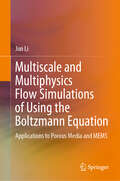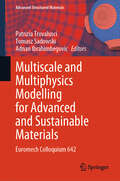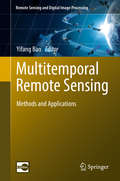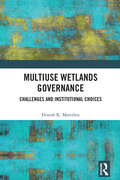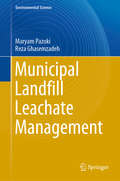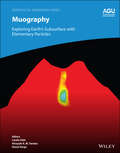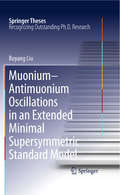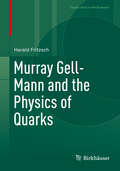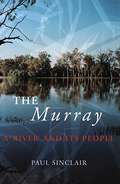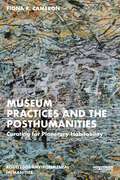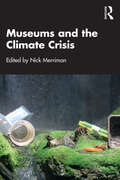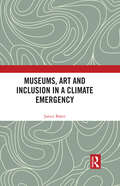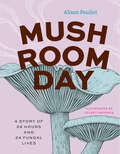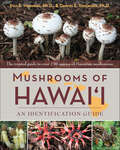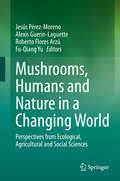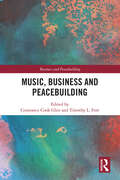- Table View
- List View
Multiscale and Multiphysics Flow Simulations of Using the Boltzmann Equation: Applications to Porous Media and MEMS
by Jun LiThis book provides a comprehensive introduction to the kinetic theory for describing flow problems from molecular scale, hydrodynamic scale, to Darcy scale. The author presents various numerical algorithms to solve the same Boltzmann-like equation for different applications of different scales, in which the dominant transport mechanisms may differ. This book presents a concise introduction to the Boltzmann equation of the kinetic theory, based on which different simulation methods that were independently developed for solving problems of different fields can be naturally related to each other. Then, the advantages and disadvantages of different methods will be discussed with reference to each other. It mainly covers four advanced simulation methods based on the Boltzmann equation (i.e., direct simulation Monte Carlo method, direct simulation BGK method, discrete velocity method, and lattice Boltzmann method) and their applications with detailed results. In particular, many simulations are included to demonstrate the applications for both conventional and unconventional reservoirs. With the development of high-resolution CT and high-performance computing facilities, the study of digital rock physics is becoming increasingly important for understanding the mechanisms of enhanced oil and gas recovery. The advanced methods presented here have broad applications in petroleum engineering as well as mechanical engineering , making them of interest to researchers, professionals, and graduate students alike. At the same time, instructors can use the codes at the end of the book to help their students implement the advanced technology in solving real industrial problems.
Multiscale and Multiphysics Modelling for Advanced and Sustainable Materials: Euromech Colloquium 642 (Advanced Structured Materials #231)
by Patrizia Trovalusci Tomasz Sadowski Adnan IbrahimbegovicThis book offers the proceedings of Euromech colloquium 642, which wanted to provide a forum to present and debate several advanced computational, experimental, and analytical methods for studying the behaviour of complex materials and structures. The goal was to gather researchers (engineers, physicists, and mathematicians) specialized in multiscale material modelling for simulating the mechanics of solids and the physics of matter with the final aim of bridging the gap between solids and structural mechanics and material science in the modelling of “complex” materials. Both computational and experimental aspects play a central role, and talks have also focused on a broad range of aspects either related to the material modelling or the structural one. Various types of complex materials, made of very different constituents, are used nowadays in engineering practice: particle or fibrous composites; laminates; green composites with natural fillers and industrial or urban recyclable materials; nanomaterials; architecture material; in general complex multiphase materials with a complex internal structure including: porosity, reinforcement in the form of short fibres and particles of various properties, shapes, and sizes, filled in different media. It is widely recognized that important macroscopic properties such as the macroscopic stiffness and strength are governed by multiphysics processes (e.g. damage due to heat transfer or fluid penetration, crack propagation under thermal shock in ceramic/metallic matrix composites, etc.) which occur at one to several scales below the level of observation. A thorough understanding of how these processes influence the reduction of stiffness and strength is a key to the analysis of existing, and the design of improved, complex materials. The colloquium was centred on “Multiscale and Multiphysics Modeling of Complex Materials”, with attention to the constitutive aspects concerning complex materials, so defined for the presence of internal structure at different scales (nano/micro/meso) and nonlinear constitutive behaviour (plasticity, damage, fracture, etc.).
Multitemporal Remote Sensing: Methods and Applications (Remote Sensing and Digital Image Processing #20)
by Yifang BanWritten by world renowned scientists, this book provides an excellent overview of a wide array of methods and techniques for the processing and analysis of multitemporal remotely sensed images. These methods and techniques include change detection, multitemporal data fusion, coarse-resolution time series processing, and interferometric SAR multitemporal processing, among others. A broad range of multitemporal datasets are used in their methodology demonstrations and application examples, including multispectral, hyperspectral, SAR and passive microwave data. This book features a variety of application examples covering both land and aquatic environments. Land applications include urban, agriculture, habitat disturbance, vegetation dynamics, soil moisture, land surface albedo, land surface temperature, glacier and disaster recovery. Aquatic applications include monitoring water quality, water surface areas and water fluctuation in wetland areas, spatial distribution patterns and temporal fluctuation trends of global land surface water, as well as evaluation of water quality in several coastal and marine environments.This book will help scientists, practitioners, students gain a greater understanding of how multitemporal remote sensing could be effectively used to monitor our changing planet at local, regional, and global scales.
Multiuse Wetlands Governance: Challenges and Institutional Choices
by Dinesh K. MarothiaThe Ramsar Convention was established in 1971 to ensure the conservation and wise use of wetlands across the world. India joined the Convention in 1982, however, in the past 50 years despite Ramsar’s incredible achievements, the threat to wetlands across the globe, including India, has not diminished. This book studies the governance of multiuse wetlands in India. The volume provides an exhaustive analysis of rural, peri-urban and urban human-made wetlands to establish the relevance of institutional design and the effective role of authority in governing multiuse wetland ecosystem services. The author argues that the most challenging task in governing wetlands is to frame institutional choices that users and non-users comprehend, and agree to pursue under alternative property rights regimes. Drawing on extensive fieldwork, the book provides a broader look into the causes and consequences of wetland ecosystem degradation and offers insights into improved sustainable management systems for different types of multiuse wetlands. It will be indispensable for students and researchers of environmental studies, sustainable development, biodiversity, conservation, agricultural, natural, and environmental resource economics.
Municipal Landfill Leachate Management (Environmental Science and Engineering)
by Maryam Pazoki Reza GhasemzadehThis book is divided into seven chapters, which address various leachate landfill management issues such as the quality, quantity and management of municipal landfill leachate, together with new methods. There are many methods available for the treatment and management of municipal landfill leachate. The waste management methods presented here can be applied in most third-world countries, due to the lack of waste separation and high organic content of waste. The book provides descriptions and a hierarchy of waste management, reviews the history of solid waste disposal, and covers a range of topics, including: leachate and gas generation in landfills; natural attenuation landfills; landfill site selection; leachate and stormwater management, collection and treatment; landfill gas management; landfill cover requirements; leachate collection; types of natural treatment systems; and design procedure and considerations. In closing, it provides an overview of the current solid waste management status in Iran.
Muography: Exploring Earth's Subsurface with Elementary Particles (Geophysical Monograph Series)
by László Oláh Hiroyuki K. M. Tanaka Dezső VargaMuography Muography Exploring Earth’s Subsurface with Elementary Particles Hidden out of sight in Earth’s subsurface are a range of geophysical structures, processes, and material movements. Muography is a passive and non-destructive remote sensing technique that visualizes the internal structure of solid geological structures at high resolution, similar in process to X-ray radiography of human bodies. Muography: Exploring Earth’s Subsurface with Elementary Particles explores the application of this imaging technique in the geosciences and how it can complement conventional geophysical observations. Volume highlights include: Principles of muography and pioneering works in the field Different approaches for muographic image processing Observing volcanic structures and activity with muography Using muography for geophysical exploration and mining engineering Potential environmental applications of muography Latest technological developments in muography The American Geophysical Union promotes discovery in Earth and space science for the benefit of humanity. Its publications disseminate scientific knowledge and provide resources for researchers, students, and professionals.
Muonium-antimuonium Oscillations in an Extended Minimal Supersymmetric Standard Model
by Boyang LiuThis innovative work investigated two models where the muonium-antimuonium oscillation process was mediated by massive Majorana neutrinos and sneutrinos. First, we modified the Standard Model only by the inclusion of singlet right-handed neutrinos and allowing for general renormalizable interactions producing neutrino masses and mixing. The see-saw mechanism was employed to explain the smallness of the observed neutrino masses. A lower bound on the righthanded neutrino mass was constructed using the experimental limits set by the nonobservation of the muonium-antimuonium oscillation process. Second, we modified the Minimal Supersymmetric Standard Model by the inclusion of three right-handed neutrino superfields. The experimental result of the muonium-antimuonium oscillation process generated a lower bound on the ratio of the two Higgs field VEVs. This work helps to set up relationships between the experimental result of the muonium-antimuonium oscillation process and the model parameters in two specific models. Further improvement of the experiment in the future can generate more stringent bounds on the model parameters using the procedure developed by this work.
Murray Gell-Mann and the Physics of Quarks (Classic Texts in the Sciences)
by Harald FritzschMurray Gell-Mann, Physics Nobel Prize Laureate in 1969 is known for his theoretical work on elementary particle physics and the introduction of quarks and together with H. Fritzsch the “Quantum Chromodynamics”. Based on four sections the Editor gives an overview on the work of Gell-Mann and his contributions to various aspects of the physics, related to quarks. His most important and influential papers were selected and reprinted so that the reader easily can check the original work of Gell-Mann.
Murray: A River And Its People
by Paul SinclairThe Murray River is in crisis, and faces an uncertain future. In this evocative book, Paul Sinclair explores the reasons why the river has become degraded, and what these changes have meant to Australians. This in-depth study of the Murray River examines the changing cultural meanings of the river: the practical forgetfulness which has eroded the Aboriginal presence; the triumphant narratives in which a supposedly empty land is made purposeful by the life-giving powers of the Murray; the passion to make the river's flow predictable and to replace 'primitive' forces with a domesticated and balanced landscape. The focus is on shifts and changes. Sinclair describes the brief heyday of the riverboats and their transformation into a tourist attraction; the decline of the mighty Murray cod and the rise of the European carp; and the changing fortunes of the river towns. He demonstrates that 'progress' is often a myth, and that ecological degradation always has cultural costs. This is an innovative cultural and environmental history, about landscape and fish, memory and concepts, imagination and desire. Through a complex interweaving of history, analysis, poetry, art, and individuals' recollections, Paul Sinclair has created an original and subtly conceived work, offering imaginative space to think about land and water in new ways. Fishermen, farmers, tourists, environmentalists, lovers of the Australian landscape—all these people will want to read this beautifully written book. It will be an essential resource for those directly involved in the future of the Murray River, contributing to the larger debate about Australia's threatened environment.
Museum Practices and the Posthumanities: Curating for Planetary Habitability (Routledge Environmental Humanities)
by Fiona R. CameronThis book critiques modern museologies and curatorial practices that have been complicit in emerging existential crises. It confidently presents novel, more-than-human curatorial visions, methods, frameworks, policies, and museologies radically refiguring the epistemological foundations of curatorial, museological thinking, and practice for a habitable planet. Modern curatorial and museological practices are dominated by modern humanism in which capital growth, social, technological advancement, hubris, extraction, speciest logics, and colonial domination predominate, often without reflection. While history, science, and technology museums and their engagement with non-human worlds have always been ecological as an empirical reality, the human-centred frameworks and forms of human agency that institutions deploy tend to be non-cognizant of this reality. Museum Practices and the Posthumanities: Curating for Planetary Habitability reveals how these practices are ill-equipped to deal with the contemporary world of rapid digital transformations, post-Covid living, climate change, and its impacts among other societal changes, and it shows how museums might best meet these challenges by thinking with and in more-than-human worlds. This book is aimed at museological scholars and museum professionals, and it will provide them with the inspiration to conduct research on and curate from a different ecological reference point to promote a world good enough for all things to thrive in radical co-existence.
Museums and the Climate Crisis
by Nick MerrimanMuseums and the Climate Crisis shows how museums can respond to the interrelated global climate, biodiversity and pollution crises. They have a unique role because they take a long-term perspective, and their scholarship and independence mean that they remain trusted by the public. Providing insights and international case studies from a range of museum and gallery professionals, academics and consultants, this book explores how museums can use this unique perspective to engage the public as active citizens, and how they are exemplars of good practice in areas such as emissions reduction and encouraging biodiversity. It shows how museums can combat climate exhaustion by drawing on understandings about positive motivation, and how to develop exhibitions, events and activities that motivate visitors to take action. Taking a broad approach beyond purely climate issues, the contributions touch on the use of renewables, environmental controls and standards, travel (including virtual couriering), waste management (including recycling, plastic reduction and composting), reducing pollution and increasing biodiversity within museums. Museums and the Climate Crisis will be important reading to those studying in the fields of Museum Studies, Heritage Studies and Conservation. Taking a practical approach, it will also be beneficial to museum, gallery and heritage professionals who are grappling with the challenges of the climate crisis.
Museums, Art and Inclusion in a Climate Emergency
by Janice BakerMuseums, Art and Inclusion in a Climate Emergency considers the impact of the Anthropocene on history and memory, approaches to objects and agency and the incommensurability of western and Indigenous ontologies. Drawing on Indigenous knowledge, humanities and museological literature, continental philosophy, contemporary art and popular culture, Baker acknowledges the autonomous agency of geological forms, including soils, minerals and fossil fuels. Demonstrating that this has implications for an expanded idea of an ‘inclusive’ museum and its relationship to entities beyond ‘life’ and living species, the book argues that the ‘inclusion’ paradigm needs to include nonlife actors. Gesturing to a geontological ‘turn’ through developing notions of geo-inclusion, the mineralhuman and approaches to object agency that connect with Aboriginal ‘heritage’, Baker exposes the ongoing destruction of Country by mining interests in Western Australia and elsewhere. By addressing the need for urgent change through the artifice of the museum, the book identifies an expanded approach to inclusion beyond the limits imposed by the politics of identity. Museums, Art and Inclusion in a Climate Emergency theorises the potential of an expanded idea of the museum and will be of interest to scholars and students engaged in the study of museums and heritage, environmental humanities and geo-humanities, ecological art history and contemporary art.
Mushroom Day: A Story of 24 Hours and 24 Fungal Lives (Earth Day)
by Alison PouliotAn hourly guide that spotlights twenty-four fungus species as they spread spores, find food, and adapt to a changing planet. On this mushroom-filled day, ecologist Alison Pouliot tours the world to introduce readers to a fascinating variety of fungi. Each chapter of Mushroom Day introduces a single fungus during a single hour, highlighting twenty-four different species. In the dark of the night, the green glow of the ghost fungus guides us into the forest to learn about the mysteries of bioluminescence. At dawn, we awaken to find a fairy ring of mushrooms that has appeared overnight like something out of folklore. But we don’t have much time to linger, as we must reach the Italian forest before other porcino hunters forage the morning’s fattest and finest. In the heat of the afternoon, the ripe stench of the stinkhorn might send us out of the woods, while the enticing aroma of the aniseed funnel lures us back in. Late in the evening we spy a fungus known as the witches cauldron and wonder what it might tell us about the future. By the end of our mushroom day, we’ll have glimpsed the diversity of this unique kingdom, met fungus friends that feed and fascinate, and learned how humans can encourage their flourishing. For each hour, celebrated artist Stuart Patience has depicted these scenes with evocative pen and ink illustrations. Working together to narrate and illustrate these unique moments in time, Pouliot and Patience have created an engaging read that is a perfect way to spend an hour or two—and a true gift for foragers, mycophiles, and anyone who wants to stop and appreciate fungi.
Mushrooms of Hawai'i: An Identification Guide
by Dennis E. Desjardin Don E. HemmesHawai'i is known for its verdant mountains and colorful ocean ecosystems, but few realize the depth and range of the islands' mushroom diversity. In fact, Hawai'i is home to over 230 species of mushrooms that are prized by foragers from around the world. In Mushrooms of Hawai'i, Don Hemmes and Dennis Desjardin present a beautiful and comprehensive guide to the treasure trove of mycological life in the Aloha State. Inside you'll find information on Mushroom identification Culinary and medicinal uses of Hawaiian mushrooms Where to find the best mushroom-hunting spots The seasonality of Hawaiian mushrooms And everything else you might need to make your foraging adventure a success. Mushrooms of Hawai'i also includes beautiful illustrations to help you identify familiar treasures like morels, well-known dangers like Amanita muscaria, and exciting species unique to the islands. Whether you're hunting Copelandia cyanescens ("magic" mushrooms) in the pasture grasses high in the mountains of Maui, or foraging for Laetiporus (chicken of the woods), an edible mushroom sought after by foodies for its uniquely delicious taste, this book is the must-have guide for fungophiles.
Mushrooms, Humans and Nature in a Changing World: Perspectives from Ecological, Agricultural and Social Sciences
by Jesús Pérez-Moreno Alexis Guerin-Laguette Roberto Flores Arzú Fu-Qiang YuThis book focuses on recent advances in our understanding of wild edible mycorrhizal fungi, truffle and mushrooms and their cultivation. In addition to providing fresh insights into various topics, e.g. taxonomy, ecology, cultivation and environmental impact, it also demonstrates the clear but fragile link between wild edible mushrooms and human societies. Comprising 17 chapters written by 41 experts from 13 countries on four continents, it enables readers to grasp the importance of protecting this unique, invaluable, renewable resource in the context of climate change and unprecedented biodiversity loss. The book inspires professionals and encourages young researchers to enter this field to develop the sustainable use of wild edible mushrooms using modern tools and approaches. It also highlights the importance of protecting forested environments, saving species from extinction and generating a significant income for local populations, while keeping alive and renewing the link between humans and wild edible mushrooms so that in the future, the sustainable farming and use of edible mycorrhizal mushrooms will play a predominant role in the management and preservation of forested lands.
Music and the Performing Arts in the Anthropocene: Nature, Materialities and Ecological Transformation (Routledge Explorations in Environmental Studies)
by François Ribac Isabelle Moindrot Nicolas DoninMusic and the Performing Arts in the Anthropocene offers a series of thought-provoking chapters about music and the performing arts viewed from current Anthropocene-aware perspectives. From the use of gas, water and air in 19th-century stage practices to the ecology of musical instruments and sound reproduction technologies, waste and carbon print in experimental music and theatrical production, knowledge of precariousness and empowerment through music in a changing world, each chapter aims at highlighting an issue that has always been here but never looked at thoroughly, due to the divides and hierarchies of the modern cosmogony.Gathering 16 scholars from a variety of disciplinary backgrounds (history of literature, opera and theatre studies, musicology, sound studies, sociology, information science, etc.), this volume reflects on the relationships between the performing arts, music and environmental issues. It also explores a number of tools for changes and sketches how we will understand the arts, their history and their future beyond ecocriticism.This book will be of great interest to students and scholars in the humanities and social sciences, as well as a broader readership involved in art and environment policies.
Music, Business and Peacebuilding (Business and Peacebuilding)
by Timothy L. Fort Constance Cook GlenBusiness schools are placing more emphasis on the role of business in society. Top business school accreditors are shifting to mandating that schools teach their students about the social impact of business, including AACSB standards to require the incorporation of business impact on society into all elements of accredited institutions. Researchers are also increasingly focused on issues related to sustainability, but in particular to business and peace as a field. A strong strain of scholarship argues that ethics is nurtured by emotions and through aesthetic quests for moral excellence. The arts (and music as shown specifically in this book) can be a resource to nudge positive emotions in the direction toward ethical behavior and, logically, then toward peace. Business provides a model for positive interactions that not only foster long-term successful business but also incrementally influences society. This book provides an opportunity for integration and recognition of how music (and other art forms) can further encourage business toward the direction of peace while business provides a platform for the dissemination and modeling of the positive capabilities of music toward the aims of peace in the world today. The primary market for this book is the academic audience. Unlike many other academic books, however, the interdisciplinary nature of the book allows for multiple academic audiences. Thus, this book reaches into schools of music, business, political science, film studies, sports and society studies, the humanities, ethics and, of course, peace studies.
Muskrat for Supper
by Kenny SalweyMuskrat for Supper inspires young people to explore nature's life cycles and understand the concept of the circle of life, as told through the tale of a family that embarks on a hunting and trapping adventure. It is an endearing story that weaves together such themes as sustainable living, our natural environment, and living closer to nature. The first book for children by this acclaimed storyteller and author, Muskrat for Supper includes questions young people have asked Kenny Salwey about his lifestyle as a river rat living off the land. The story will be illustrated with black-and-white photographs as well as nonfiction material to supplement the text. Kenny Salwey is the last of a breed of men whose lifestyle has all but disappeared in this fast-paced, high-tech digital world. For thirty years, this weathered woodsman eked out a living on the Mississippi River running a trapline, hiring out as a river guide, digging and selling roots and herbs, and eating the food he hunted and fished. Today Salwey is a master storyteller, environmental educator, keynote speaker, nature writer, and advocate for the Upper Mississippi River. He has presented his true-life adventures and words of natural world wisdom to both adult and young audiences across the upper Midwest. By sharing his hard-learned experiences, his respect for the Mississippi River, and his love of the natural world, Salwey hopes to inspire his audiences to protect this precious and fragile ecosystem.
Muslim Environmentalisms: Religious and Social Foundations
by Anna M. GadeHow might understandings of environmentalism and the environmental humanities shift by incorporating Islamic perspectives? In this book, Anna M. Gade explores the religious and cultural foundations of Islamic environmentalisms. She blends textual and ethnographic study to offer a comprehensive and interdisciplinary account of the legal, ethical, social, and empirical principles underlying Muslim commitments to the earth.Muslim Environmentalisms shows how diverse Muslim communities and schools of thought have addressed ecological questions for the sake of this world and the world to come. Gade draws on a rich spectrum of materials―scripture, jurisprudence, science, art, and social and political engagement―as well as fieldwork in Indonesia and Southeast Asia. The book brings together case studies in disaster management, educational programs, international development, conservation projects, religious ritual and performance, and Islamic law to rethink key theories. Gade shows that the Islamic tradition leads us to see the environment as an ethical idea, moving beyond the established frameworks of both nature and crisis. Muslim Environmentalisms models novel approaches to the study of religion and environment from a humanistic perspective, reinterpreting issues at the intersection of numerous academic disciplines to propose a postcolonial and global understanding of environment in terms of consequential relations.
Mutual Sustainability of Tubewell Farming and Aquifers
by Ahmad Saeed KhattakThis book develops and presents a conceptual model for sustainable-groundwater irrigated agriculture. The model is based on the general principles of the economic theories of cost-benefit relations and behavioral models of resource use. The study has evaluated the advances in tubewell farming and the aquifer potential in arid Balochistan over a period of three decades. It has analyzed the booms and busts of the farming over time taking into consideration the local aquifer limitations and the socio-political considerations and policy framework. Three data sets - farmers, expert officials and satellite images - have been used to aid validation. By observing the most vital parameters, the study has concluded that the local aquifer has been falling at a rate directly proportional to the growth rate of irrigated farming, suggesting the current development process is unsustainable. For instance, the research finds that tubewell bores have reached down to depths where the term "aquifer mining" applies; as a result, irrigation costs have become too high to allow farming to be economically viable. In addition, desertification is steadily encroaching and the cropping pattern being changed from high-value horticulture to subsistence cropping. The study has also set parameters for assessing the willingness of farmers to accept modern, sustainable strategies and interventions.
My Awesome Field Guide to Rocks & Minerals: Track and Identify Your Treasures (My Awesome Field Guide for Kids)
by Gary LewisBecome a rock hound with this field guide for kids ages 7 to 10The world of rocks and minerals is massive, amazing, and full of cool new things to uncover! My Awesome Field Guide to Rocks and Minerals teaches you the skills you need to collect, identify, and catalog your own treasures.Explore 150 different rocks and minerals, and get step-by-step guidelines for testing and identifying the ones you encounter out in the field. There's also plenty of notebook space so you can record data about your finds. So get out there, gather cool looking samples, and discover what they are!My Awesome Field Guide to Rocks and Minerals includes:An intro to earth science—Explore the layers of the earth, how rocks and minerals are formed, the periodic table, and more essential information for young scientists.Handy fact sheets—Learn more about all kinds of unique rocks and minerals with fact sheets that are conveniently organized to help with identification.A field notebook—Record all your rock-hunting sample data on pages that include cut-out numbers for cataloging.Identify and catalog rocks and minerals with this fascinating field guide that has everything you need to get started.
My Backyard Jungle: The Adventures of an Urban Wildlife Lover Who Turned His Yard into Habitat and Learned to Live with It
by James BarillaFor James Barilla and his family, the dream of transforming their Columbia, South Carolina, backyard into a haven for wildlife evoked images of kids catching grasshoppers by day and fireflies at night, of digging up potatoes and picking strawberries. When they signed up with the National Wildlife Federation to certify their yard as a wildlife habitat, it felt like pushing back, in however small a way, against the tide of bad news about vanishing species, changing climate, dying coral reefs. Then the animals started to arrive, and Barilla soon discovered the complexities (and possible mayhem) of merging human with animal habitats. What are the limits of coexistence, he wondered? To find out, Barilla set out across continents to explore cities where populations of bears, monkeys, marmosets, and honeybees live alongside human residents. My Backyard Jungle brings these unique stories together, making Barillaâ TMs yard the centerpiece of a meditation on possibilities for coexistence with animals in an increasingly urban world. Not since Gerald Durrell penned My Family and Other Animals have readers encountered a naturalist with such a gift for storytelling and such an open heart toward all things wild.
My Book of Rocks and Minerals: Things to Find, Collect, and Treasure (My Book of)
by Devin DennieA stunning visual reference book for little geologists who love to find fascinating rocks all around them. Identify colorful gemstones, sparkly crystals, the toughest rocks, and ancient fossils. Packed with fun facts, information, and extensive photos all about the rocks and minerals that make up the world around us.Interactive learning that engages young scholarly minds. Learn about 64 different types of rocks and minerals, how to tell the difference between them and where to find them. Dig into all the interesting geological materials from deep space to the deepest caves. You&’ll even discover glow in the dark minerals and living gems!Find out about the stuff our world is made of, and how rocks and minerals form over time. This captivating book introduces children to hands-on science with fun activities like starting your own impressive rock collection and how to stay safe on your rock finding missions.Written for kids aged 6 to 9 with bite-sized information and explanations. The easy-to-understand language gives them a rock-solid foundation for science subjects. The geology book includes the phonetic pronunciation of the rock and mineral names so your little one will sound like a rock expert in no time.Rockin&’ It With Stones And Minerals • Stunning high-quality photographs. • Inspiring activities for little Earth scientists. • Over 64 types of rocks, their properties, and how they are formed.
My Butterfly Bouquet
by Nicola DaviesWith breathtaking illustrations and a touching story, this dazzling picture book introduces young readers to one of nature's most magnificent and essential insects: the butterfly.See how a little girl recovering from poor health finds wonder in nature and delights in planting a garden with her father to attract a fascinating array of butterflies. Exploring the life stages of butterflies, their importance to our ecosystems and the revitalising power of nature, this book is a heart-warming information story for children who love the outdoors and all its incredible creatures.At the back of the book, discover tips on how to create your own wildlife garden to attract betterflies!
My Encyclopedia of Very Important Oceans (My Very Important Encyclopedias)
by DKA charming children's encyclopedia that takes you on a journey into the deep blue to discover the wonders of the world&’s oceans!The world is so much bigger than young minds can fathom and there is always more to learn. My Encyclopedia of Very Important Oceans is a vibrant encyclopedia for curious 5-7 year olds, who want to know everything there is to know about life on and under the waves. Easily accessible to young readers through a balance of striking images and conversational, age-appropriate text, this ocean encyclopedia will tap into every child&’s natural curiosity and answer all their biggest questions about this amazing world under the water. Bursting with up-to-date facts and discoveries, this exciting kid&’s encyclopedia includes everything from the spectacular seabirds soaring over Earth&’s vast oceans, to the tiny creatures lurking on the ocean floor. Dive in and explore forgotten shipwrecks, swim with fabulous fish and other awesome underwater animals, and weave your way through secret deepsea homes. You&’ll travel back in time to meet plundering pirates, scientists, and explorers who changed the course of history, then it&’s time to learn about lots of very important underwater jobs and how you can help to protect Earth&’s precious oceans.Celebrate your child&’s curiosity as they:- Read fun facts about weird and wonderful ocean creatures- Learn important ocean conservation efforts for awareness around the climate crisis - Discover curious creatures and incredible under-the-sea adventures Our ocean encyclopedia for children is the perfect blend of striking illustrations, fun fact files and educational stats about oceanographic life. In fact, &‘oceans&’ is an on-trend topic, with more and more wildlife books with an environmental focus seeing an increase in sales. Encourage early learners to go on a journey into under the water to explore a world of information, making this the ideal first reference book for kids aged 5-7 to enjoy for hours on end, whether shared reading with the family, or reading alone, this fun fact book for children also doubles up as the perfect gift for all young ocean lovers. Tell the story of underwater world one page at a time, by uncovering: - Educational content written in a friendly and fun manner - Beautifully padded cover with several high-quality finishes, including padding and foil- Features a built-in ribbon bookmark so you never lose your place whilst reading More in the SeriesMy Encyclopedia of Very Important Oceans is part of the educational kid&’s book series My Very Encyclopedia series. Complete the series and nurture your child's curiosity with My Encyclopedia of Very Important Adventures, teach them about different species with My Encyclopedia of Very Important Animals, or let them go back in time to when dinosaurs roamed the earth with My Encyclopedia of Very Important Dinosaurs.
